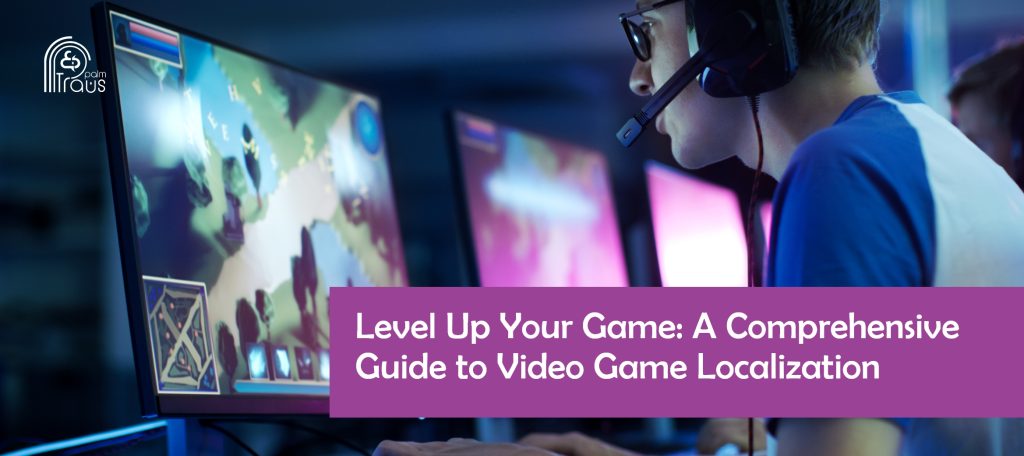Video game localization can be the stage your video game needs to conquer the global market. Like all other aspects of our lives, globalization has impacted the video game industry, driving up the demand for localized games and expanding the industry’s reach worldwide.
Thanks to video game localization, you open the doors to a diverse audience of players from around the globe, all eager to dive into the immersive experience you’ve crafted with imagination and hard work.
This expansion not only enhances the player experience but also translates into substantial financial gains. In 2023, the global video game market generated an impressive $365.6 billion in revenue,
So, in the following lines, we will explore the critical importance of video game localization, outline the steps to achieve effective localization and address common challenges you may encounter along the way.
What is video Game Localization?
Video game localization refers to the process of adapting a game’s content to a particular target market. The goal of video game localization is to assist the target audience in relating to and successfully interacting with the localized versions of the game.
This video game localization process includes but is not limited to translating the game content from the source language into the target language. It also includes adapting the game content to the cultural references and the linguistic context of the target audience.
To achieve optimal results, the localization process must cover all aspects of the game, including text, audio, visuals, and user interface/user experience (UI/UX) elements. This holistic approach ensures that the game feels natural and engaging to players from diverse linguistic and cultural backgrounds, enhancing their overall gaming experience.
3 Compelling Reasons to Localize Your Video Game
The gaming market has skyrocketed in recent years, becoming one of the world’s largest entertainment industries. By 2027, the gaming market is expected to grow from its current value of $282 billion to more than $363 billion. This remarkable growth has significantly heightened the demand for game localization.

But you might now be weighing the costs and benefits of game localization. It’s true that localizing your game requires an investment of both time and resources and in an industry where rapid market entry and cost-efficiency are crucial, these factors can’t be ignored.
However, the potential returns of video game localization far outweigh these considerations. So, let’s have a quick look at the three compelling reasons why investing in video game localization services is essential for your game’s success.
1- Gain a Competitive Edge
Localization serves as a powerful differentiator that gives your game a real competitive edge. When you localize your game, you’re not just translating its content—you’re creating an immersive experience that speaks directly to players in their native tongue.
Games are all about the experiences they create and if players are faced with a choice between two similar games, they would always prefer the one that feels familiar, the one that resonates with their cultural context.
A well-localized game does more than communicate; it connects. It demonstrates respect for the player’s culture and enhances their gaming experience, fostering a sense of belonging and engagement.
2- Build a Global Brand
The video game localization process will introduce your game to new target audiences and aid it in entering new target markets, which means penetrating the international video game market and building a strong presence.
As a result, your brand will receive more respect and appreciation in the global video game industry, and you will be able to build strong bonds of mutual respect and loyalty with your audience and gamers.
3- Boost Player Engagement
Localizing your video game is one of the main methods to boost your player engagement and satisfaction. And why does this matter to you?
The answer lies in the effect of players’ satisfaction. A player who feels truly satisfied with the experience your game offers is more likely to share their positive experience.
They become unofficial ambassadors for your game, spreading the word through their social networks, online communities, and gaming circles.
This word-of-mouth marketing is not just free; it’s incredibly effective, as people tend to trust recommendations from friends and fellow gamers more than traditional advertising.
The 7-Step Video Game Localization Process
The video game localization process is long and complicated, consisting of seven main steps that require a full localization team specialized and experienced in localizing video games for different languages and markets.
Let’s have a look at how professional video game localization goes through pre-production and during actual localization
1- Pre-Production Planning
In a video game localization project, pre-production planning is as important as carrying out the localization process itself, if not deemed even more important.
The importance of this stage lies in its ability to create an orderly system, which helps the localization team to deliver an efficient video game localization project. This stage includes setting a localization strategy, an actual localization plan, and creating a schedule for each stage of the localization process, and deciding which target markets to invade next.
Pre-production planning entails doing extensive research on the target language and its cultural references. It also means doing a deep analysis of the source files, attempting to decipher all the parts of the game and reaching its very core.
2- Internationalization:
Another necessary step is internationalization, which ideally takes place during the development of the game, but even if you are past the establishing stage, internationalization is still quite doable.
Internationalization is simply preparing your video game from the get-go to be relevant to as many multilingual audiences from as many different markets as possible, which means setting your video game on the road of globalization from the very beginning.
Internationalization will simplify any future necessary localization projects and greatly minimize their costs.
3- Text Extraction and Preparation:
In the stage of text extraction and preparation, all attention is drawn to the in-game texts and how to properly deal with them to bring about the best results.
The game text is not limited to the phrases and sentences that show on the screen but also the speech of all the characters of the game.
The localization team attempts to analyze the game text and decide which of the game texts can be translated and which is better to be rewritten from scratch to suit the target audience.
So, in this stage, the localization team will focus on preparing the game’s translatable content for translation and designing the content that needs to be written specifically for the localized versions of the game.
4- Translation, Transcreation, and Localization:
Translation, transcreation, and localization are methods through which the localization team can treat the game content professionally.
Video game translation is rendering the game content from the source language to the target language and sticking to the meaning, style, and intent of the original text.
Transcreation is similar to translation in that it preserves the essence of the text, but it does so in a style that suits the target audience and their linguistic, social, and cultural references.
While video game translation constitutes an integral component of the video game localization process, localization goes beyond translation; it’s adapting the game text to the target language and the target audience by any means the localization team deems fit.
5- UI/UX Adaptation:
UI/UX adaptation is an essential step in the video game localization process, and without it, the whole localization effort would be wasted.
UI stands for User Interface, which is the video game’s interface that allows the player to interact with the game. As for UX, it stands for User Experience and refers to the gaming experiences that the player gets.
Therefore, it is important to adapt the User Interface (UI) to the target audience’s language and culture to present them with a smooth interaction with the game.
Adapting User Experience (UX) happens through adapting all the elements that might improve the players’ gaming experiences, such as: the storyline, the characters, the gaming controls, the language, etc.
6- Quality Assurance and Testing:
Now that you have adapted the whole game to the linguistic and cultural references of the target market, it’s time to test your game and see if your efforts have paid off or not.
The goal of quality assurance is to make sure that the localized versions of your game meet no difficulty in playing, and that the game is clear from any errors or accidental misconduct of the localization process.
Quality assurance is divided into three main categories: linguistic testing, in which the testers make sure there are no mistakes in the translation, and cultural testing, in which the testers make sure the target culture is depicted accurately and is clear from any offensive stereotyping.
Quality assurance also includes functional testing, in which the testers make sure all parts of the game play properly and the gamer will face no difficulties.
7- Post-Release Support and Updates:
The localization process doesn’t end with the release of the localized versions of the game but persists during the stages of post-release support and announcing updates.
Post-release support includes providing channels through which you can receive feedback from your customers, analyzing this feedback, and working to solve any issues they might have encountered while playing.
You also need to continuously update your game, whether to fix bugs or to add new features. Make sure to regularly make game announcements with any updates or news about the localized versions of the game across suitable platforms.
Common Challenges in Game Localization and How to Overcome Them
Sometimes, game developers meet some challenges and difficulties in game localization, and many creative localization teams have developed creative solutions. Let’s discuss some of these challenges and how to overcome them:
1- Cultural Nuances and Humor
Adapting your video game to the cultural nuances and humor of a target market can be a bit tricky. One of the very successful methods to overcome such a challenge is to do extensive research on the target audience and their cultural references to avoid making any mistakes.
For example, the localization team of Dragon Quest XI could successfully adapt all the Japanese cultural references and humorous puns to the target culture without alienating the gamer or causing confusion.
2- Text Expansion and UI/UX Constraints:
The same sentence in different languages and different linguistic systems will have different lengths. For example, a one-line sentence in English can be way shorter or longer in Japanese. In order to overcome this, you need to get a bit creative in how you handle the language and its layout.
Try to fetch other synonyms and use the linguistic features of the target language that would fit your UI better. Alternatively, you can try out different font styles, font sizes, and responsive typography until you are satisfied with your final UI.
3- Voice-Over and Dubbing:
To ensure the best gaming experiences for your customers, you need to hire voice-over actors who are suitable for the various roles across the various target languages you’re localizing into.
This can be a bit difficult, and the search for suitable voice-over agents that deliver the lines efficiently can be a bit dreary. Though, collaborating with local voice-over companies can help you find the right actors and aid you in training them to deliver their lines skillfully.
4- Managing Costs and Timelines:
Localization can be consumed on more than one level, and the process can exploit your time and your pocket profusely. These losses can risk the ability to launch the localized versions of the game and also lead to further losses in other projects.
To avoid such problems, resort to a professional video game localization agency with a strong localization team that has produced many successful localization projects. Working with professionals might be a bit costly at first, but it will save you lots of money and time in the long run.
Transform Your Game for Global Success with TransPalm
TransPalm teams have the expertise to elevate your game across various platforms, including video games, online games, websites, mobile games, and PC games.
Don’t let language barriers limit your game’s success. Contact us and embark on a localization journey that will position your game as a standout in the global gaming industry.
Take Your Game To A Global Level!
Discuss Your Project with Our Experts.





